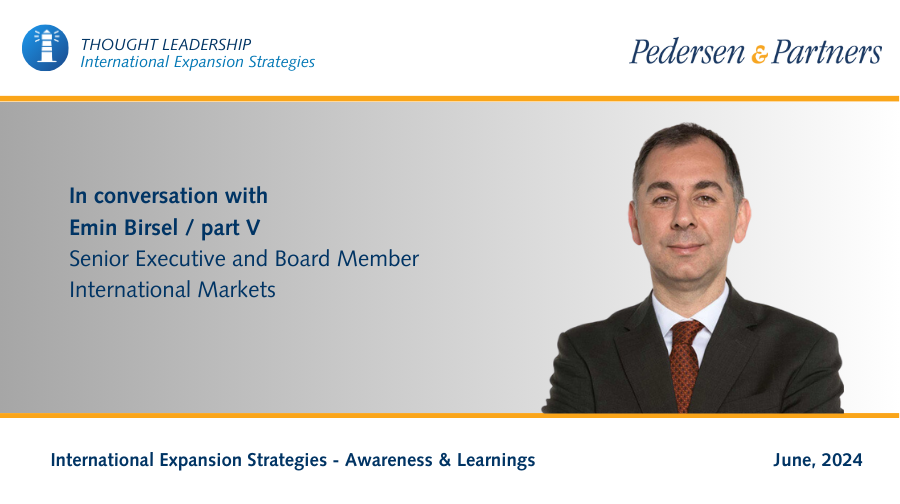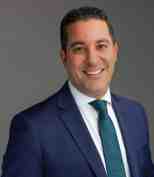Navigating International Expansion: Awareness & Learnings
By Sabit Tapan, Partner, Global Key Account Development at Pedersen & Partners and Emin Birsel, Senior Executive and Board Member - International Markets:
Sabit: Hello, Emin. We've discussed international market expansion from various angles. Once a company operates in a host country, it encounters new realities, both positive and negative. Based on your experience, how should companies learn from negative outcomes in the international markets?
Emin: Hello, Sabit. Stepping into an international expansion project, companies may be confronted with a few unexpected developments. The first possible situation, is deviating from original plans due to the new or unexpected market realities. The second is facing issues that the company and the organization are and were not exposed in their domestic markets. Many companies have a plan or investment thesis. Hence, plans and thesis immediately start getting tested.
Among various issues, investment project cycles may be longer. Customer purchasing cycles may take longer. For example, I have seen companies who step into European or American markets to realise later that there are strict listing windows for new products.
If you have missed that listing window for your product, the next time you could place your product on the shelf can only be the next year. Many times, companies find out that the synergies that they thought were going to be there between parent, subsidiary and other group companies are not as large, or will take a longer time to realize and or material investments. You can also find yourself facing difficult organisational challenges; the new organisation or the new stakeholders may not be as welcoming as you wish they were.
Obviously, you must evaluate the reasons why the expansion is not going well and make the necessary changes. It's not a shame to adapt your strategy. You may find yourself needing to localise your approach. This may include customising your products, services, marketing campaigns, customer support or management approach, indifferent ways that were not imagined earlier. A good example is Procter & Gamble’s experience in Japan. After struggling for many years and it is only when they have found their exact market success recipe that they thrived. So even for the most experienced companies and their brands, it may take a while to prosper.
You must build relationships and invest in talent while seeking also external expert advice.
You cannot place yourself in a vacuum. You must build alliances with your stakeholders to understand exactly what's happening. Also, you must be flexible and patient and learn from your mistakes. If this is particularly the first international expansion, there are a lot of learnings that can be taken from here and adapted to future projects.
Sabit: Very interesting that you have mentioned that companies should not be ashamed of re-considering their original plans. Do companies often prioritize maintaining their original strategy over restructuring their approach or redefining their strategy, viewing it as a matter of business principle or pride?
Emin: I would say that this is mostly an emotional topic. There is a lot of vested interest. The board, the CEO, the management, everybody wants this project to succeed. And there is actually wishful thinking many times where the companies may be getting blindsided and the strategy is actually a choice of products, a marketing campaign, or recruitment of some key people. By setting aside emotional considerations and leveraging strategic insights from stakeholders, the company can effectively address such circumstances and overcome them.
Sabit: Do you see companies planning such failures in their scenarios or are these faced as unexpected? How do you see companies absorbing unexpected developments into their plans?
Emin: I have rarely seen companies preparing themselves robustly for such eventuality. Everyone is vested in success. Usually, the board or the management chooses one course of action, follows it and want to give it its proper time. Early in my career, I have seen some companies that made sure that they understand the worst possible outcomes, assign a probability to it, make it part of their investment plan and move forward.
I have seen this practice in non-profit space as well. Sometimes the negative outcome can be so overwhelming that nobody wants to think or talk about it. However, I have rarely seen organisations that robustly discuss, dig deeper or formalise these scenarios.
Sabit: The caveat is to assign the right probability to the negative outcome so that you can plan accordingly. You've mentioned that the other bucket is about issues companies may not have faced in their domain in their domestic markets, but these becoming very critical or sensitive in the host markets. Inherently, some of the natural points are diversity, and being considered as a direct foreign investment. These are issues on diversity and inclusion. What are the critical points to think about these items?
Emin: Diversity is potentially a huge asset to leverage for international companies. A proactive and positive approach needs to be taken to make sure that the company can benefit from it. To start with diversity must be recognized, respected and managed proactively and carefully. Understanding and navigating cultural settings and differences require a high level of cultural sensitivity, but also adapting to and really understanding the local work culture, hierarchy, even the decision-making processes.
The leaders and leadership teams must set good examples of how diversity should be managed, but the companies must also realize that even with the best of intentions, there may be issues. Unconscious biases are just a simple and obvious example. There may be cultural integration difficulties and difficulty in promoting inclusivity. Addressing those proactively is going to make the company stronger than where it started. Think about diversity and inclusion together and foster a culture of inclusion where all the employees feel that they can contribute to the outcome.
It starts with senior leaders required to demonstrate a strong commitment to diversity and inclusion. With their behaviours, their words and their decisions, it is important to involve employees from diverse backgrounds in the decision-making process. Obviously, training and education programs towards that topic are fairly important.
Sabit: When you've mentioned diversity and inclusion being natural issues in international expansion, my question would be, are these to be tolerated or to be sought after, to add value to the original company? These are two completely different perspectives. One can be a cost of doing international business. The other is the benefit of doing international business.
Emin: Diversity and inclusion are important traits of international companies that need to be celebrated. A richness that gives them a competitive advantage. I think it's well documented in the management literature and research about how diversity can positively impact the performance of the companies. It is very important to make sure that during the talent acquisition, even the language of that talent acquisition shows how the company values and celebrates diversity and looks at it as something sought after.
In addition to having good intentions, it’s crucial that companies adopt an analytical approach. Organizations should gather and scrutinise data related to recruitment, retention, and promotion, which includes demographics and hiring trends. Essentially, companies need to set aside subjective perspectives and objectively assess the diversity within their organisation through quantifiable metrics.
Sabit: Exactly. Getting into talent acquisition issues related to the international markets, the general tendency is to seek local leadership in the host country.
Companies always try to find a way to find an association, a common ground instead of fully accepting that it is fully diverse.
Indeed, while industry similarity may be a factor, companies often look beyond quantitative data when seeking talent. They value qualitative attributes that contribute to diversity and inclusion. These attributes, which may include cultural fit, leadership potential, or unique skills, can greatly enhance the richness and effectiveness of a team. This holistic approach to talent acquisition is key to building a diverse and inclusive workforce. When it relates to talent acquisition, what are the success factors? What companies should do to add value to their process?
Emin: I think Pedersen & Partners is the expert on this one. The search for affinity often results in unconscious bias. There are tools available in the market that companies utilise for performance-based recruitment and talent acquisition. Furthermore, some companies are adopting practices to redact CVs to ensure gender neutrality or to minimise the prominence of demographics, age, or geographic location. This approach helps to mitigate bias and promotes a more diverse and inclusive hiring process. Assisting managers in selecting candidates with the highest performance expectations is indeed a challenging task. However, it’s essential for companies to focus on indicative data. By analysing the data, companies can gain valuable insights into their performance and make informed decisions. This data-driven approach can significantly improve the effectiveness of their recruitment and talent management strategies.
Sabit: Our experience shows that companies are increasingly setting specific targets within their talent acquisition processes to ensure outcomes align with their objectives. These targets often encompass various aspects of diversity, including gender. This proactive approach to diversity and inclusion is a marked shift from practices observed 20 years ago, reflecting the evolving priorities in today’s corporate landscape.
Emin: Absolutely. Inclusion is a critical aspect of the talent acquisition and recruitment process. After making significant efforts to attract a diverse range of talent, it’s important to avoid creating isolated groups or subcultures within the organisation. Instead, companies should strive to foster an inclusive environment where everyone feels valued and can contribute to their fullest potential. This approach not only benefits the individuals but also enhances the overall performance of the organisation.
Sabit: In our previous discussions, we’ve emphasised the importance of stakeholders. When we refer to stakeholders, we’re considering all parties involved in a broad sense. So, what are the key areas where stakeholders should be actively involved to ensure success and add value?
Emin: As a company expands internationally, it encounters a new environment with both internal and external stakeholders. Many companies are often surprised by the number of external stakeholders and struggle to understand why so many others are concerned about their entry into the market or acquisition. These new stakeholders can include advisory boards, supervisory boards, works councils, unions, and local authorities.
In this context, the best solution is to communicate with these stakeholders transparently and strive to understand their perspectives and how they are linked to the company’s success. As long as companies can align their strategies with their stakeholders, they can reap tremendous benefits. Stakeholders often bring new ideas and concerns to the table, sometimes highlighting issues that even local managers may not have considered.
The second group of stakeholders, which is perhaps the most obvious, are the internal stakeholders - your local organisation.
I’ve seen many times in my career the danger of creating an ‘us and them’ culture. This breeds a very negative situation. Companies may not be able to avoid this at the outset, but they must address it quickly and in an organised manner. The solution to this is clear communication, particularly of the strategic objectives, vision, and values of the international parent company. This ensures that everyone understands the overarching goals and helps the local organisation understand their strategic role and how their strategies and KPIs align with the company’s strategic objectives.
Creating an environment where there’s mutual understanding and communication is crucial. This should be followed by empowering managers and teams in international units to make autonomous decisions.
Sabit: The key concept here is the collective mission between the home and host country organisations, creating a joint effort for success. These are crucial points that can be overlooked, even by home country organisations. They may think they’re not involved in the operations of the host country, but in reality, there’s an integrated, vested interest for the home country as well.
Emin: In the language of a home country, host country, or even when you say parent company or subsidiary, there’s a hierarchy and a ranking of things. Trying to avoid that language as much as possible and promoting the concept of ‘one company’ is a significant step and effort.
Sabit: Precisely. When you mentioned responding to the needs of the times, today’s most important topic is ESG. That’s what we see across the board. Is ESG a concern for companies embarking on international expansion? Or is it a concern for other, larger companies?
Emin: That’s a good point. ESG is already an important issue to address for many companies in their domestic markets. But once you step into international markets, the sensitivities increase.
Today, international companies are under greater scrutiny to adhere to best practices in environmental issues and sustainability. Customers and consumers are curious about what you’re doing, not only in your local market, but also in other markets, and what your global policies are.
I’d actually like to view this from a positive perspective of opportunities. I find that embracing sustainability as a policy can drive innovation and differentiation. It can lead to the development of new products, business models, and services that evolve with consumer, industry and regulatory requirements. I’ve seen many times how sustainable practices lead to cost savings across the supply chain. Reducing water and energy consumption and waste are good practices for any company, as well as for environmental concerns.
Innovative sustainable or environmental products can certainly open up access to new markets. But I also want to mention stakeholders - customers, suppliers, investors - who require and want related parties who are concerned and responsible. Local communities want this; the new generation of employees wants to work with companies that care about the environment, about the world.
I’ve seen many interviews with new-generation employees who really want to understand how the company acts on environmental issues and sustainability, and what the company’s position is. They want to associate themselves with companies that have a positive footprint.
However, this is not without challenges. Anything that can be considered a lag or lacking in a given market may be reflected on the corporation as a whole. And companies are faced with varying environmental regulations in different countries, which bring yet another layer of complexity.
Sabit: Thank you, Emin. I guess we had an opportunity to discuss details at length for all aspects of expansion to international markets. Look forward to discussing additional topics in the future.





 Tesla can quickly modify circuit boards to accommodate alternative chips, because the company designs its own circuit boards.
Tesla can quickly modify circuit boards to accommodate alternative chips, because the company designs its own circuit boards. Tesla has a team of in-house engineers who design the majority of the software in its vehicles.
Tesla has a team of in-house engineers who design the majority of the software in its vehicles.


